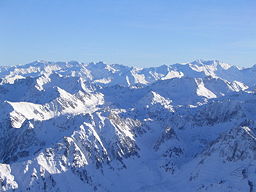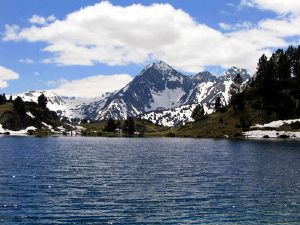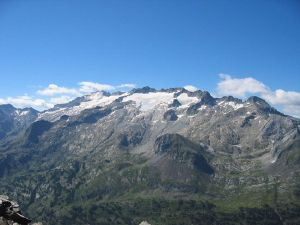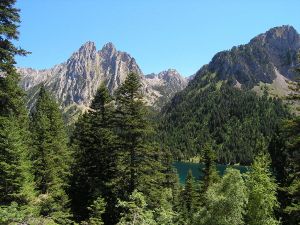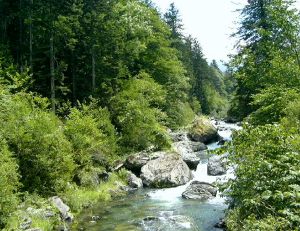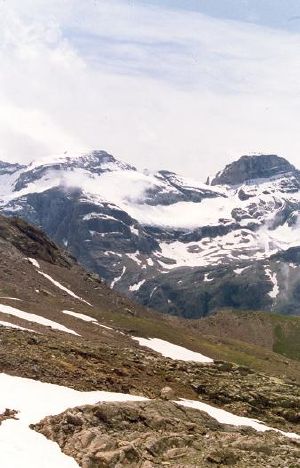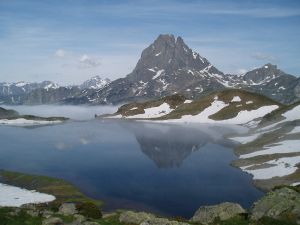Pyrenees
| Pyrenees | |
| Spanish: Pirineos Catalan: Pirineus French: Pyrénées Occitan: Pirenèus Aragonese: Perinés Basque: Pirinioak | |
| Range | |
Central Pyrenees
| |
| Named for: Pyrene | |
| Countries | Spain, France, Andorra |
|---|---|
| Highest point | Aneto |
| - elevation | 3,404 meters (11,168 feet) |
| - coordinates | |
| Geology | granite, gneiss, limestone |
| Period | Paleozoic, Mesozoic |
|
Topographic map (in French)
| |
The Pyrenees are a range of mountains in southwestern Europe that form a natural border between France and Spain. They separate the Iberian Peninsula from the rest of continental Europe, and extend for about 267 miles (430 km) from the Bay of Biscay to the Mediterranean Sea.
For the most part, the main crest forms a massive divider between France and Spain, with the tiny country of Andorra sandwiched in between. Catalonia and the Basque Country are the cultural regions that extend on both sides of the mountain range, with a northern and a southern part on each side.
According to Greek mythology the Pyrenees are named after Pyrene (fire in Greek) the daughter of Bebryx, who was supposedly raped by Herakles. Terrified by having given birth to a serpent, she fled to the mountains and was either buried or eaten by wild animals. Herodotus placed the setting of this mythological legend on his map of the Oikumene (inhabited earth) as early as 450 B.C.E.
Geography
Politically, the Spanish Pyrenees are part of the following provinces, from east to west: Girona, Barcelona, Lleida, Huesca, Navarra, and Guipúzcoa.
The French Pyrenees are also part of the following départements, from east to west: Pyrénées-Orientales, Aude, Ariège, Haute-Garonne, Hautes-Pyrénées, and Pyrénées-Atlantiques (the latter two of which include Pyrenees National Park).
The independent principality of Andorra is sandwiched in the eastern portion of the mountain range between the Spanish Pyrenees and French Pyrenees.
The Pyrenees are typically divided into three sections: the Atlantic (or western), the central, and the eastern Pyrenees. The central Pyrenees extend westward from the Aran Valley to the Somport pass, and they include the highest summits of this range:
- Pico d'Aneto or Pic de Néthou 3,404 meters (11,168 ft) in the Maladeta ridge,
- Posets peak 3,375 meters (11,073 ft),
- Mont Perdu, Monte Perdido, or Mont Perdut 3,355 meters (11,007 ft).
In the western Pyrenees the average elevation gradually increases from the west to the east, from the Basque mountains near the Bay of Biscay of the Atlantic Ocean. In the eastern Pyrenees, with the exception of one break at the eastern extremity of the Pyrénées Ariégeoises, the mean elevation is maintained with remarkable uniformity until a sudden decline occurs in the portion of the chain known as the Albères.
Geology
The Pyrenees are older than the Alps: their sediments were first deposited in coastal basins during the Paleozoic and Mesozoic eras. Between 100 and 150 million years ago, during the Lower Cretaceous period, the Bay of Biscay fanned out, pushing present-day Spain against France and putting large layers of sediment in a vise grip. The intense pressure and uplifting of Earth's crust first affected the eastern part and stretched progressively to the entire chain, culminating in the Eocene epoch.
The eastern part of the Pyrenees consists largely of granite and gneissose rocks, while in the western part the granite peaks are flanked by layers of limestone. The massive and unworn character of the chain comes from its abundance of granite, which is particularly resistant to erosion, as well as weak glacial development.
Landscape
Conspicuous features of Pyrenean scenery are:
- the absence of great lakes, such as those that fill the lateral valleys of the Alps
- the rarity and great elevation of passes
- the large number of the mountain torrents locally called gaves, which often form lofty waterfalls, surpassed in Europe only by those of Scandinavia
- the frequency with which the upper end of a valley assumes the form of a semicircle of precipitous cliffs, called a cirque.
The highest waterfall is that of Gavarnie (462 m or 1,515 ft), at the head of the Gave de Pau; the Cirque de Gavarnie, in the same valley, is perhaps the most famous example of the cirque formation. Low passes are lacking, and the principal roads and railroads between France and Spain run only in the lowlands at the western and eastern ends of the Pyrenees, near sea level. Between the two ends of the range, the only two passes worth mentioning are the Col de la Perche, between the valley of the Têt and the valley of the Segre, and the Col de Somport or Port de Canfranc, where there were old Roman roads.
A notable visual feature of this mountain range is La Brèche de Roland, a gap in the ridge line, which in legends was created by Roland, a character in medieval and Renaissance literature and chief paladin of Charlemagne. It is thought that the title character of the early twelfth-century Song of Roland, which recounts his final stand against the Vascones (an ancient people believed to be the ancestors of the present-day Basques) during the Battle of Roncevaux Pass, is based on a real person who died in that battle in 778.
Natural resources
The metallic ores of the Pyrenees are not in general of much importance now, though there were iron mines long ago. Coal deposits capable of being profitably worked are situated chiefly on the Spanish slopes, but the French side has beds of lignite. The open pit of Trimoun (Ariège) is one of the greatest sources of talc in Europe.
Mineral springs are abundant; especially noteworthy are the hot springs, which are sulphurous and mostly situated high, near the contact of the granite with the stratified rocks. The lower springs are mostly selenitic.
Climate
The amount of precipitation, including rain and snow, is much greater in the western than in the eastern Pyrenees, because of the moist air that blows in from the Atlantic Ocean. After dropping its moisture over the western and central Pyrenees, the air is usually dry over the eastern Pyrenees.
This all leads to a marked contrast between different sections of the mountain range in more than one respect. Some glaciers are found in the western and especially the snowy central Pyrenees, but the eastern Pyrenees lack glaciers because not enough snow falls there to cause them to form. The glaciers are confined to the northern slopes of the central Pyrenees, and do not descend, like those of the Alps, far down into the valleys, but have their greatest lengths along the direction of the mountain chain. They form, in fact, in a narrow zone near the crest of the highest mountains. As in the other great mountain ranges of central Europe, there is evidence of a much wider extension of the glaciers during the Ice ages.
Flora and fauna
A still more marked effect of the preponderance of rainfall in the western half of the chain is seen in the vegetation. The lower mountains in the extreme west are wooded, but the extent of forest declines eastward, and the eastern Pyrenees are wild and barren, all the more so since it is in this part of the chain that granitic masses prevail.
There is a change, moreover, in the composition of the flora in passing from west to east. In the west the flora resemble those of central Europe, while in the east they are distinctly Mediterranean in character, though the difference of latitude is only about 1° on both sides of the chain from the center, whence the Corbières stretch northeastward toward the central plateau of France.
The Pyrenees are relatively as rich in endemic species as the Alps, and among the most remarkable instances is the occurrence of the monotypic genus Xatardia (family Apiaceae), only on a high alpine pass between the Val d'Eynes and Catalonia. The genus most abundantly represented in the range is that of the saxifrages, several species of which are endemic here.
The Pyrenean ibex became extinct in January 2000; the native Pyrenean brown bear was hunted to near-extinction in the 1990s, but it was re-introduced in 1996 when three bears were brought from Slovenia. The bear population has bred successfully, and there are now believed to be about 15 brown bears in the central region around Fos, but only four native ones are still living in Aspe valley.
In their fauna the Pyrenees present some striking instances of endemism. The Pyrenean desman (an aquatic mammal) is found in some of the streams of the northern slopes of these mountains, but the only other members of this genus are confined to the rivers of the Caucasus in southern Russia. The Pyrenean euprocte (Euproctus pyrenaicus), an endemic relative of the salamander, also lives in streams and lakes located at high altitudes. Among the other peculiarities of Pyrenean fauna are blind insects in the caverns of Ariège.
Protected areas
Principal nature reserves and national parks:
- Aigüestortes i Estany de Sant Maurici National Park (Spain)
- Ordesa y Monte Perdido National Park (Spain)
- Pyrénées National Park (France)
History
The Marca Hispanica (or Spanish March, also March of Barcelona) was a buffer zone beyond the province of Septimania, created by Charlemagne in 795 as a defensive barrier between the Umayyad Moors of Al-Andalus and the Frankish Kingdom. It was known as the Upper Mark by the Caliphate to the south.
In its broader meaning, Marca Hispanica refers to a group of early Iberian lordships or counts created by the Franks, of which Andorra is the sole autonomous survivor. As time passed, these lordships merged or gained independence from Frankish imperial rule.
The area broadly corresponds to the region between the Pyrenees and the Ebro River. The local population of the March was diverse, including Iberians, Basques, Jews, and Goths who had been conquered or subjugated by the Muslim emirate to the south or the Frankish Empire to the north. The territory changed with the fortunes of the empires and the feudal ambitions of those, whether the counts or walis, appointed to administer the counties. Eventually the rulers and people of the March became autonomous and claimed independence. Out of the welter of counties in the region emerged the principalities of Navarre, Aragon, and Catalonia.
The Marca Hispanica developed as the result of three generations of fighting by the Franks and Muslims (Moors) in the Iberian Peninsula. The Muslim invasions reached the Pyrenees in the Iberian Peninsula. In 719 the forces of Al-Samh ibn Malik surged up the east coast, overwhelming the remaining Visigoth kingdom of Septimania and establishing a fortified base at Narbonne. Control was secured by offering the local population generous terms, inter-marriage between ruling families or treaties.
Further expansion was halted by defeat in the Battle of Toulouse. Wālis were installed in Girona and Barcelona. The Muslim forces however continued to raid their Frankish neighbours to the north, reaching as far as Autun.
Peace was signed in 730 between the victor at Toulouse, the Duke of Aquitaine, and 'Uthman ibn Naissa (Munuza), the Berber deputy governor of Narbonne. A peace treaty was sealed with the marriage of the Duke’s daughter to Munuza. However, when Munuza rebelled against his Andalusian masters, he was defeated and another period of Muslim expansion commenced.
In 732, Muslim forces again attacked Gaul and Aquitaine and secured initial victories, including the sacking of Bordeaux. The Duke of Aquitaine failed to secure support from his Frankish overlord, Charles Martel, who wanted to re-impose control over the dukedom. At the Battle of Tours, Charles defeated the Muslim army and repelled the invasion. Seeking to secure the southern boundary of their kingdom from further Muslim attacks, the Carolingian monarchs established a firmer control over Aquitaine.
Further campaigns in 736–37 drove the Moors further south, although Charles failed to recapture Narbonne, which was defended by both its Muslim and Visigoth citizens; however, in 759 Narbonne fell to Pippin, Charles’s son.
Pippin's son, Charlemagne, fulfilled the Carolingian goal of extending the defensive boundaries of the kingdom beyond Septimania, creating a strong barrier state between the Umayyad Emirate/Caliphate of Iberia, and the Frankish Kingdom.
Demographics and culture
Andorrans are a minority in their own country; Spaniards, Portuguese, French, Britons, and Italians make up two-thirds of Andorra's population of 71,822 (2007 estimate). Tradition holds that Charles the Great (Charlemagne) granted a charter to the Andorran people in return for fighting against the Moors.
The Basque Country had a population of about 3 million as of early 2006. The population density, at about 140/km² (360/sq. mile) is above the average of Spain or France, but the distribution of the population is fairly unequal and is concentrated around the main cities. The Greater Bilbao metropolitan area concentrates a third of the total population, while most of the interior of the French Basque Country and some areas of Navarre remain sparsely populated; density culminates at about 500/km² for Biscay but goes down at 20/km² in the northern inner provinces of Lower Navarre and Soule.
A significant majority of the population of the Basque country live inside the Basque Autonomous Community (about 70 percent of the population), while about 20 percent of the population live in Navarre and less than 10 percent in Northern Basque Country (France).[1]
Languages spoken in the area are include Spanish, French, Catalan (in Catalonia and Andorra), and Basque. Also spoken, to a minor extent, are the Occitan language (the Gascon and Languedocien dialects in France, and the Aranese dialect in the Aran Valley), and Aragonese.
Sports and leisure
Both sides of the Pyrenees are popular spots for winter sports such as alpine skiing and mountaineering. There are numerous ski resorts. The Pyreenees are also a good place for European and North African athletes to do high-altitude training in the summertime, such as by bicycling and cross-country running.
In the summer and autumn, the Pyrenees are usually featured in two of cycling's epic grand tours, the Tour de France held annually in July and the Vuelta a España held in September. The stages held in the Pyrenees are often crucial legs of both tours, drawing hundreds of thousands of spectators.
Three main long-distance footpaths run the length of the mountain range: the GR 10 across the northern slopes, the GR 11 across the southern slopes, and the HRP, which traverses peaks and ridges along a high-altitude route. In addition, there are numerous marked and unmarked trails throughout the region.
Pirena is a dog-mushing competition held in the Pyrenees.
Highest summits
|
|
|
Noted summits below 3,000 m
|
|
|
Notes
- ↑ Datutalaia and INE
ReferencesISBN links support NWE through referral fees
- Paegelow, Claus (2008). Pyrenäen Bibliografie. Andorra, spanische & französische Pyrenäen, Pyrenees Bibliography. Andorra, Spain & French Pyrenees (in German, English). Verlag Claus Paegelow. ISBN 9783000239366.
External links
- (English) Official website of France's Pyrenees National Park
- Bardenas Reales desert (Spain Pyrenees desert)
- Flying over the Pyrenees
- Great Routes: Pirineos, from a website of the Instituto de Turismo de España
- Glaciers of the Spanish Pyrenees
Coordinates:
Credits
New World Encyclopedia writers and editors rewrote and completed the Wikipedia article in accordance with New World Encyclopedia standards. This article abides by terms of the Creative Commons CC-by-sa 3.0 License (CC-by-sa), which may be used and disseminated with proper attribution. Credit is due under the terms of this license that can reference both the New World Encyclopedia contributors and the selfless volunteer contributors of the Wikimedia Foundation. To cite this article click here for a list of acceptable citing formats.The history of earlier contributions by wikipedians is accessible to researchers here:
The history of this article since it was imported to New World Encyclopedia:
Note: Some restrictions may apply to use of individual images which are separately licensed.
